Abstract
1. The responses of twenty-two spindle endings in the anterior tibial and toe extensor muscles of human subjects were studied during isometric voluntary contractions of the receptor-bearing muscle with the ankle joint fixed in 25° plantar flexion.
2. The discharge of eighteen endings accelerated in voluntary contractions when the contraction strength exceeded a threshold level which differed for different endings but was reproducible for the same ending.
3. With contractions of slow onset the latency to spindle acceleration varied with the speed of onset of the contraction. Endings with a background discharge were often unloaded by contractions until the contraction strength exceeded the threshold for activation of the ending.
4. No correlation was found between the sensitivity of a spindle to external length changes and its ease of activation in a voluntary contraction. For two spindle endings with a background discharge there was no change in either discharge frequency or the regularity of spindle discharge during contractions which were below the threshold for activation of the endings. It is concluded that the threshold for activation of a spindle ending in an isometric voluntary contraction is determined by its fusimotor innervation, and that fusimotor neurones probably have a recruitment order, much as do skeletomotor neurones.
5. Once activated, the discharge of spindle endings fluctuated with changes in skeletomotor activity but the relationship for some endings contained non-linearities. Such non-linearities were not as apparent in multi-unit recordings from a number of spindle endings in the contracting muscle. It is concluded that the fusimotor drive to a muscle is proportional to the skeletomotor drive to the muscle, and that skeletomotor and fusimotor neurones are subjected to similar if not identical descending command signals. From the work of Evarts (1968), it seems likely that these command signals are related more to desired muscle force than to desired muscle length.
Full text
PDF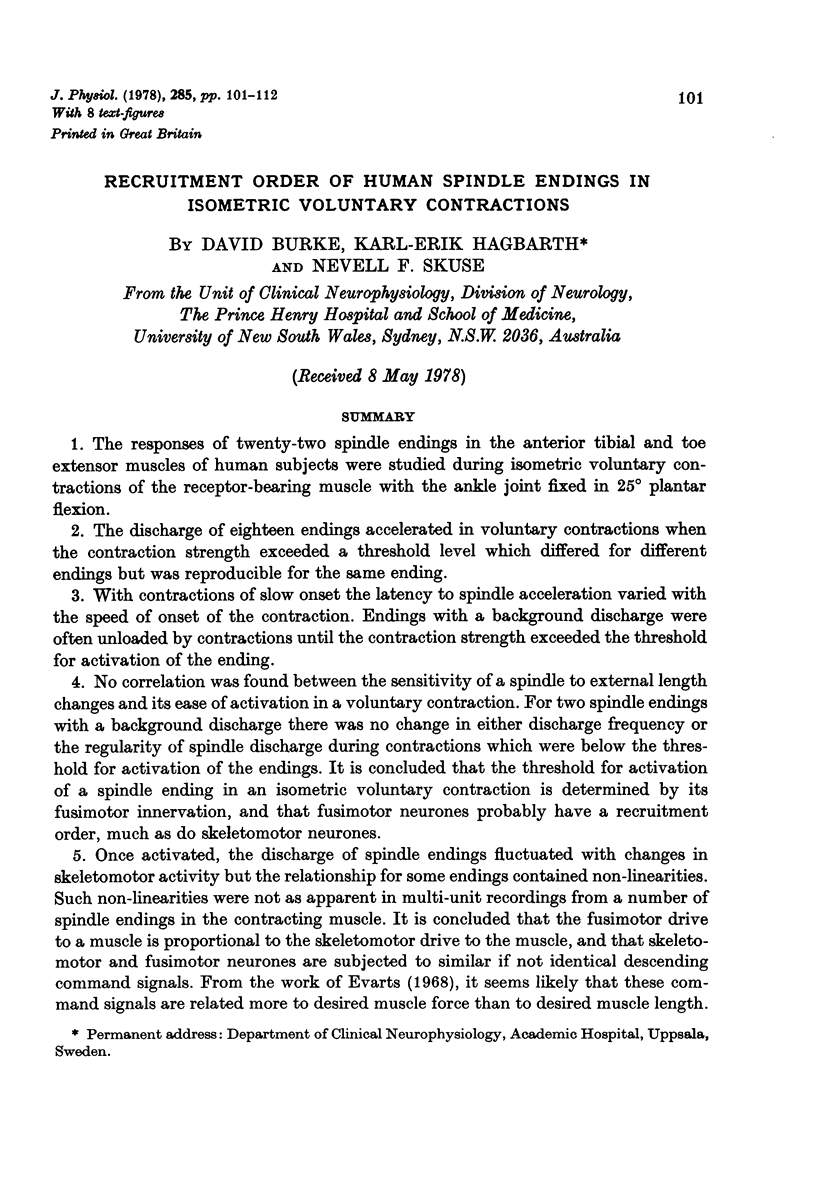
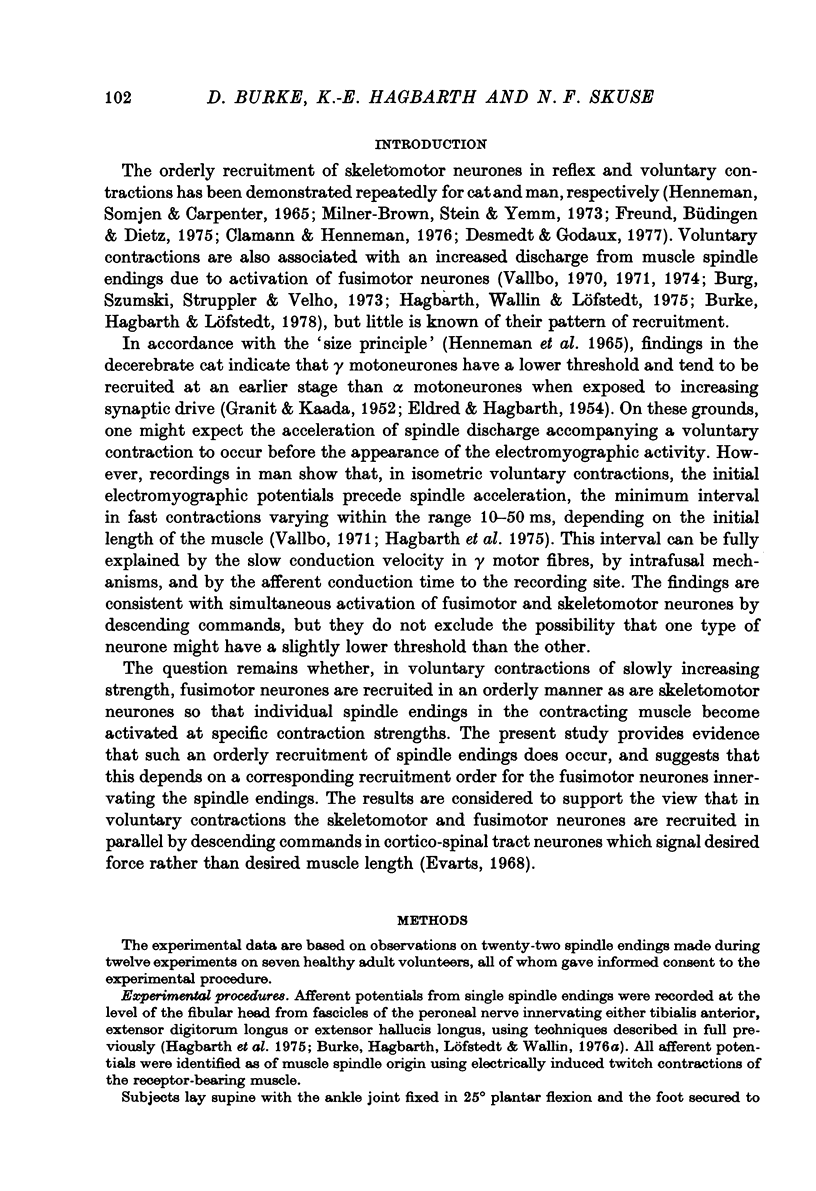
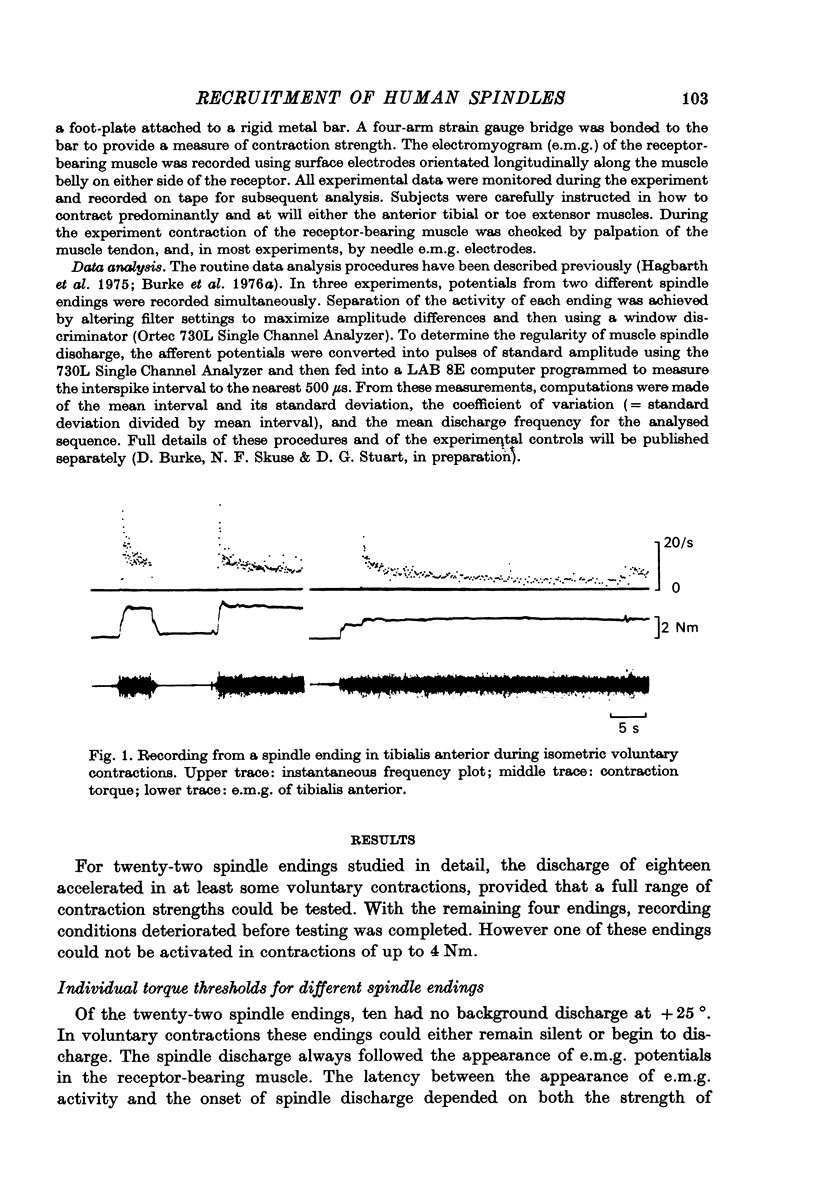
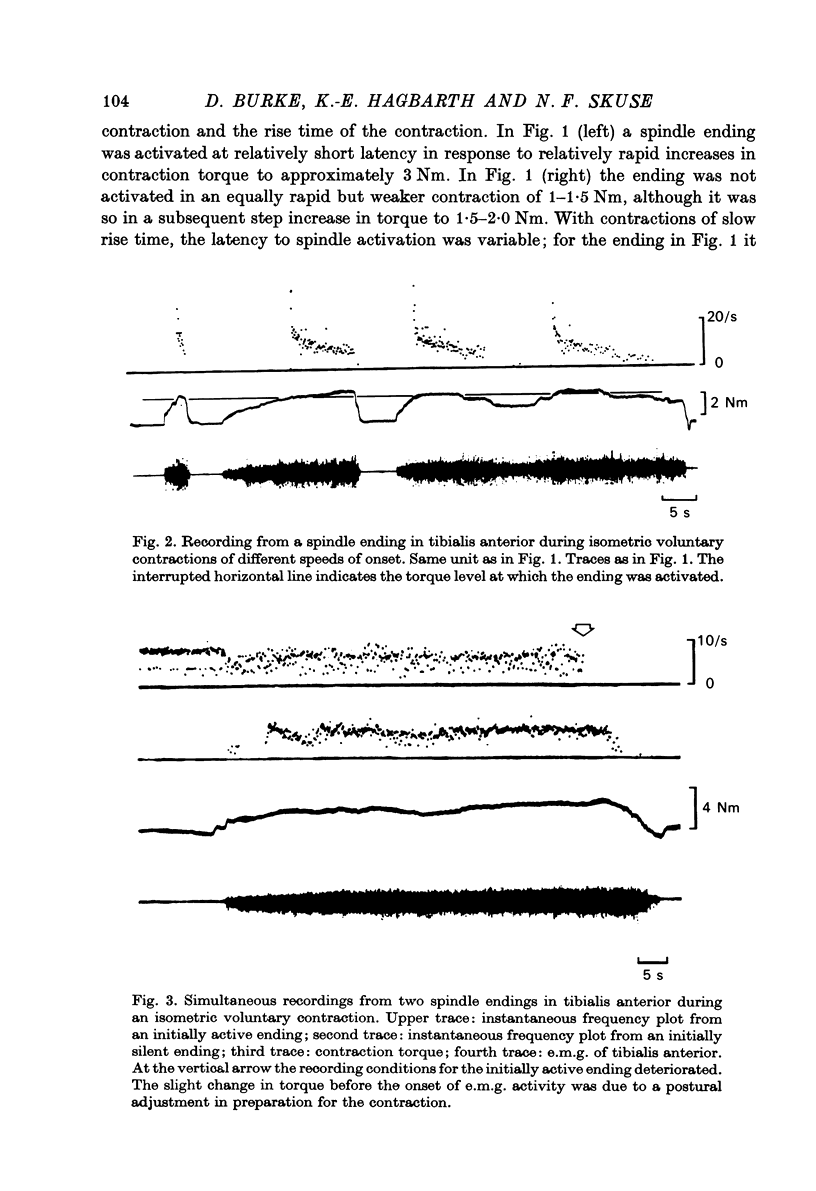
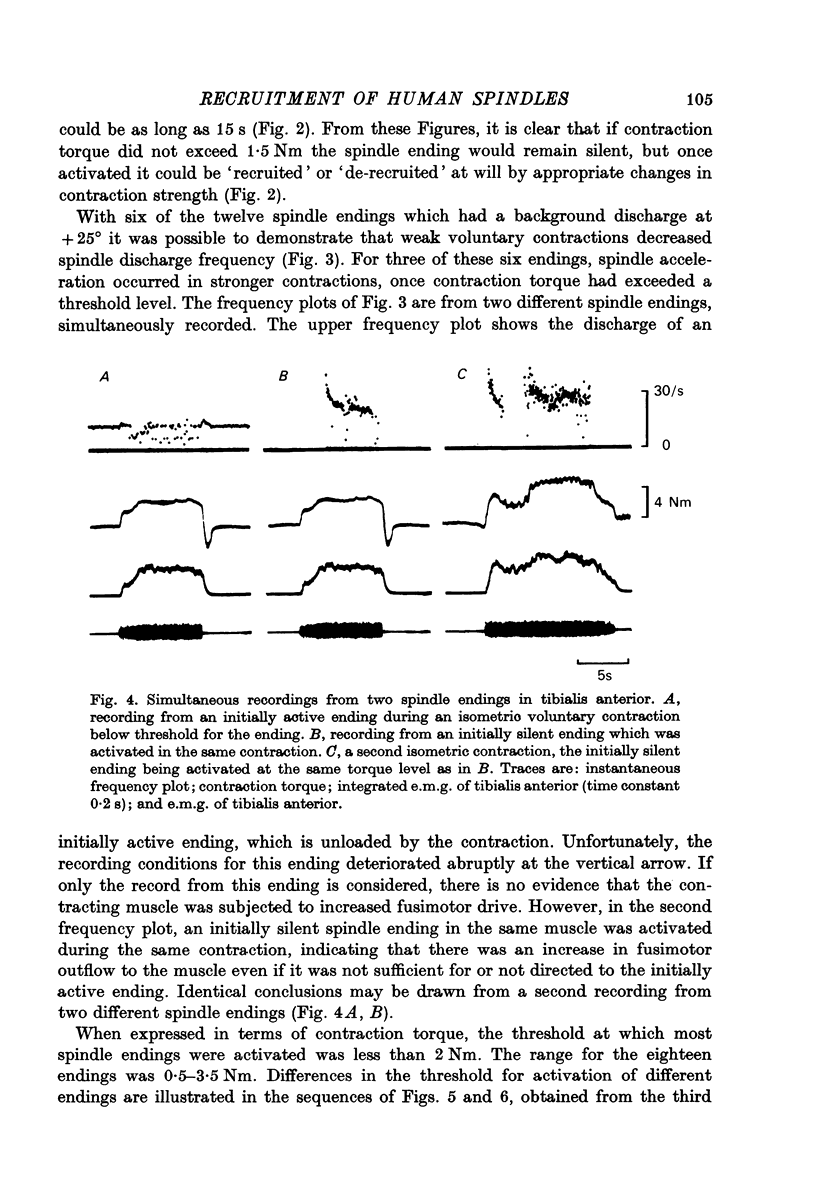
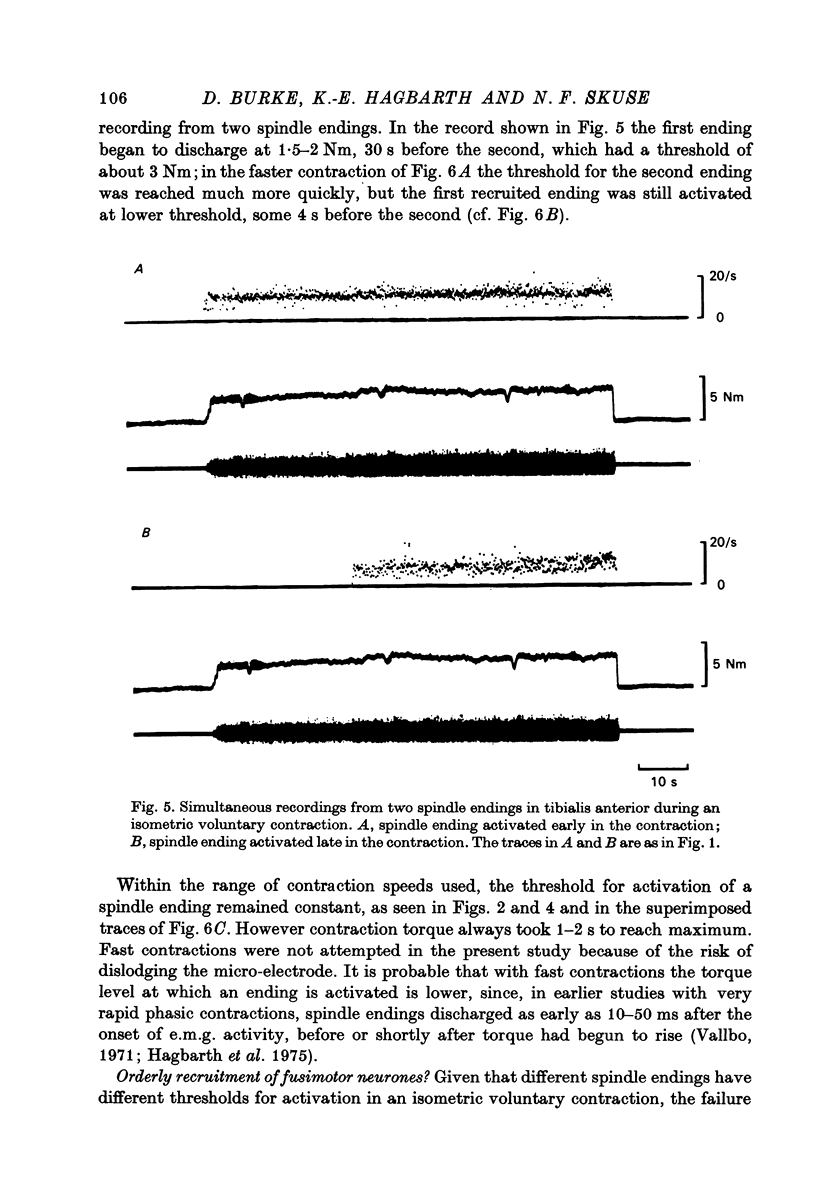
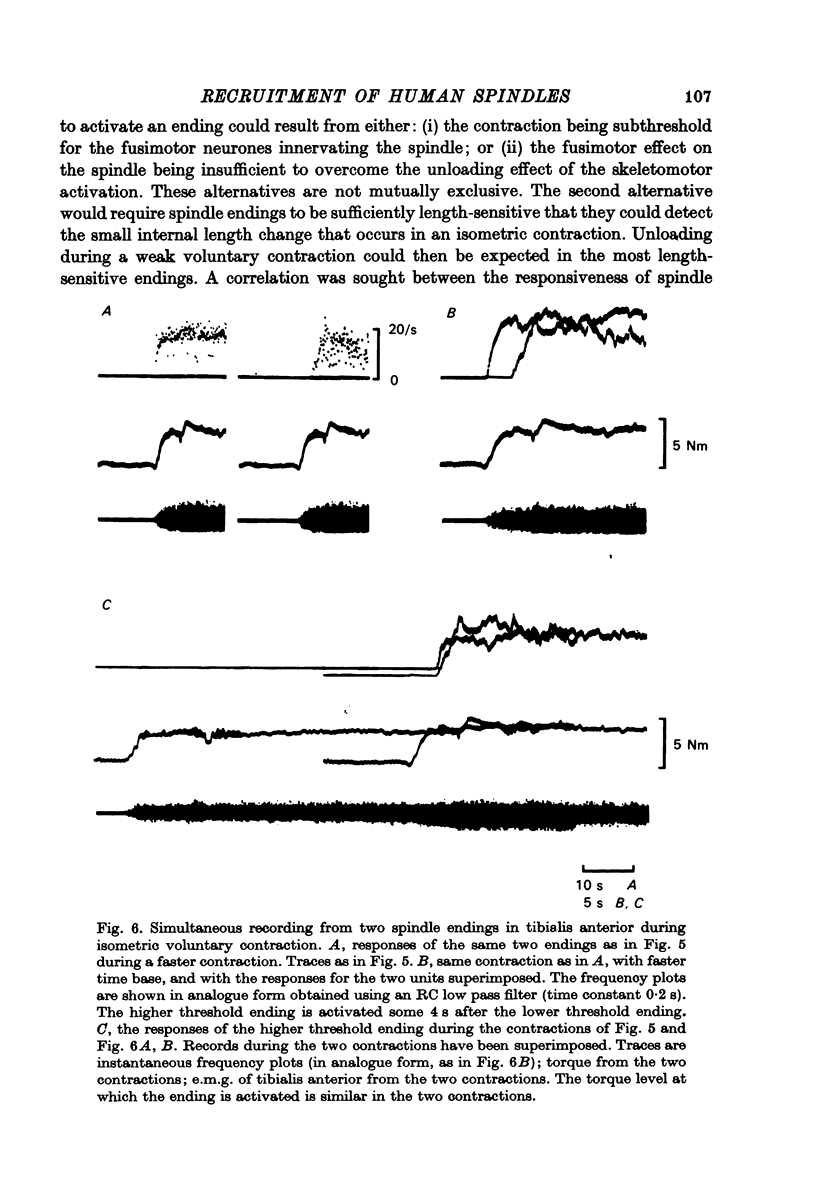
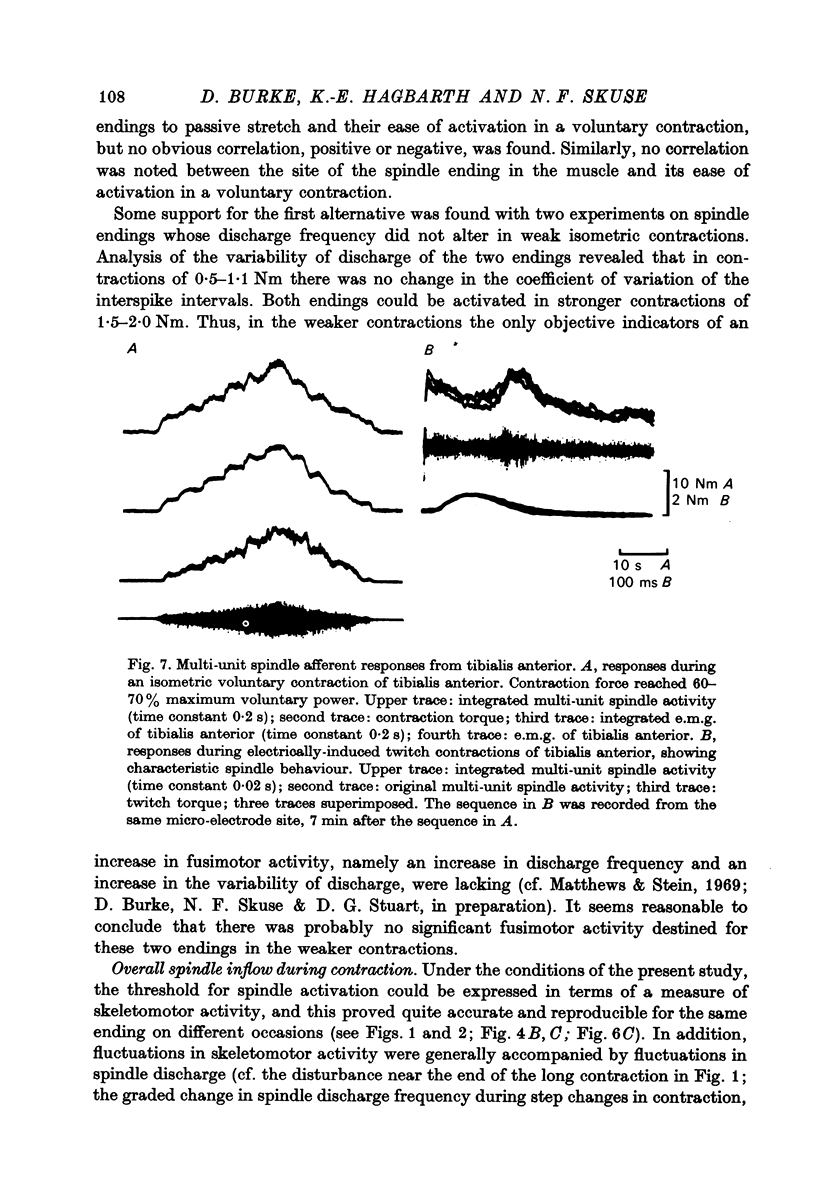
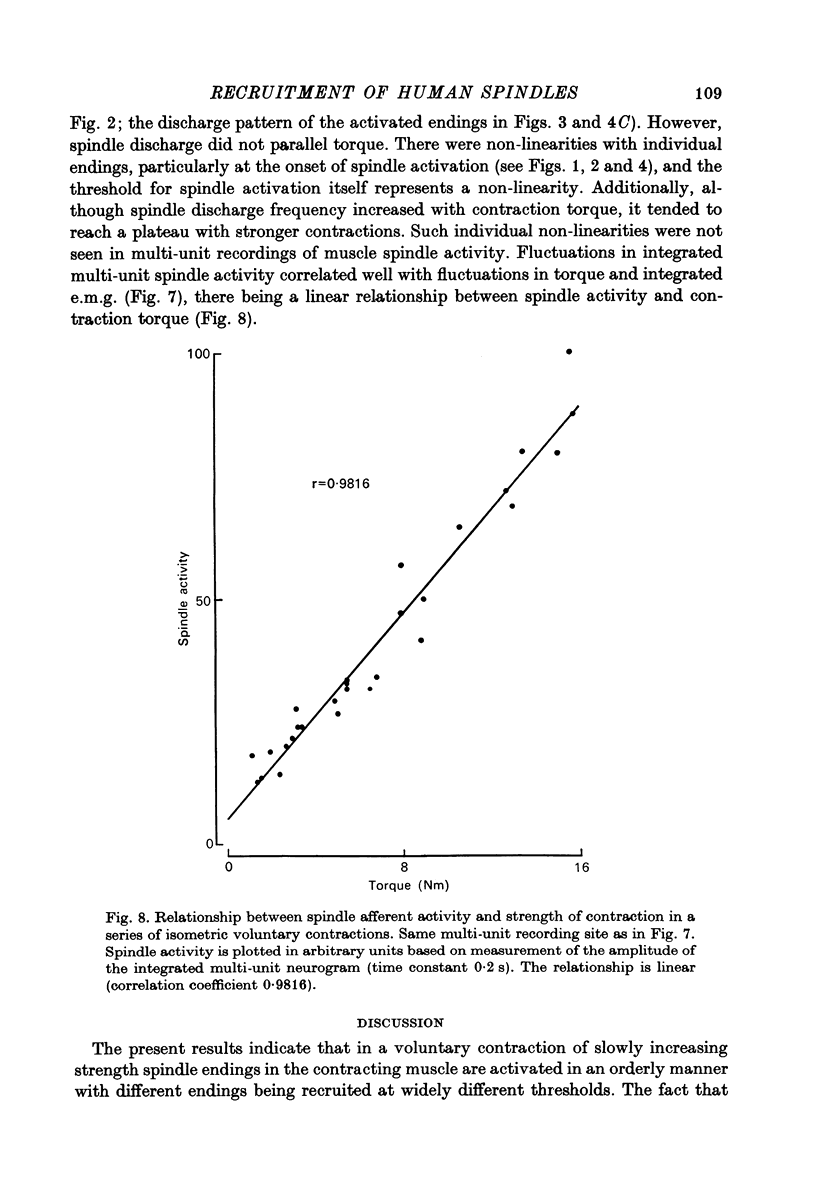
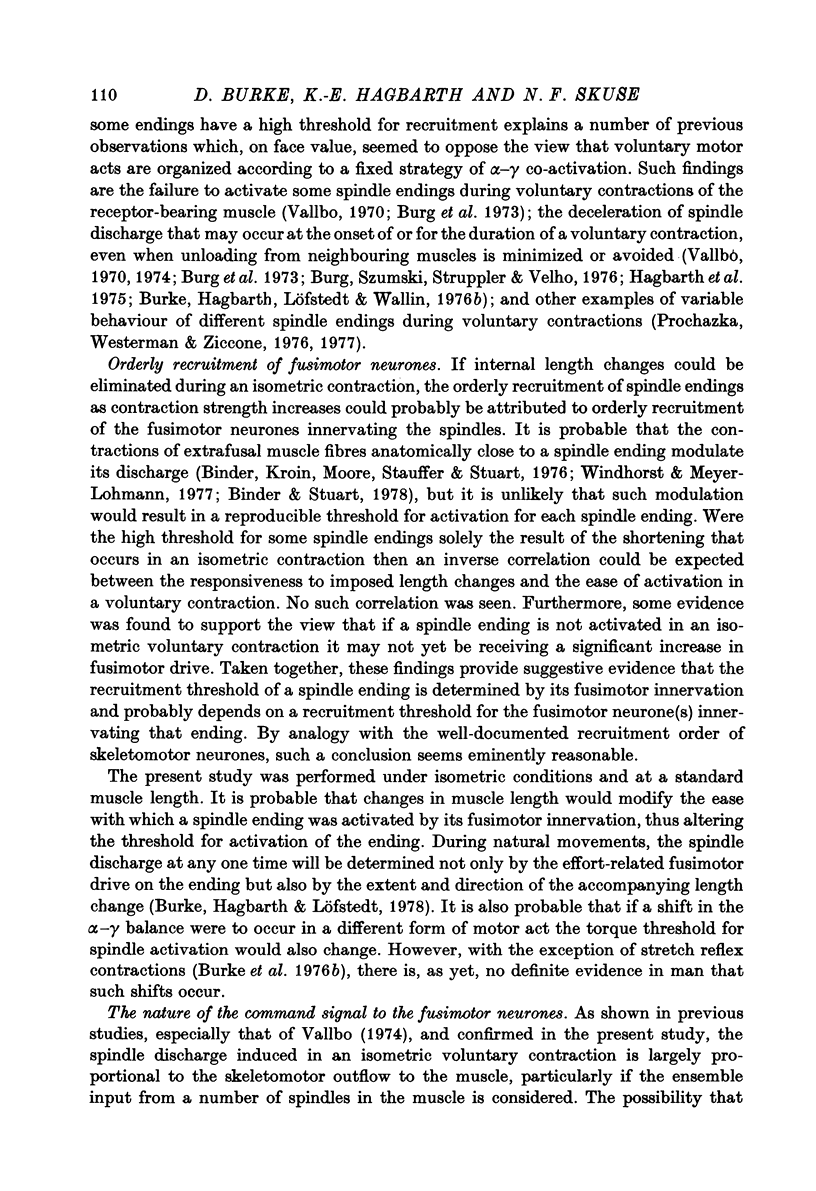
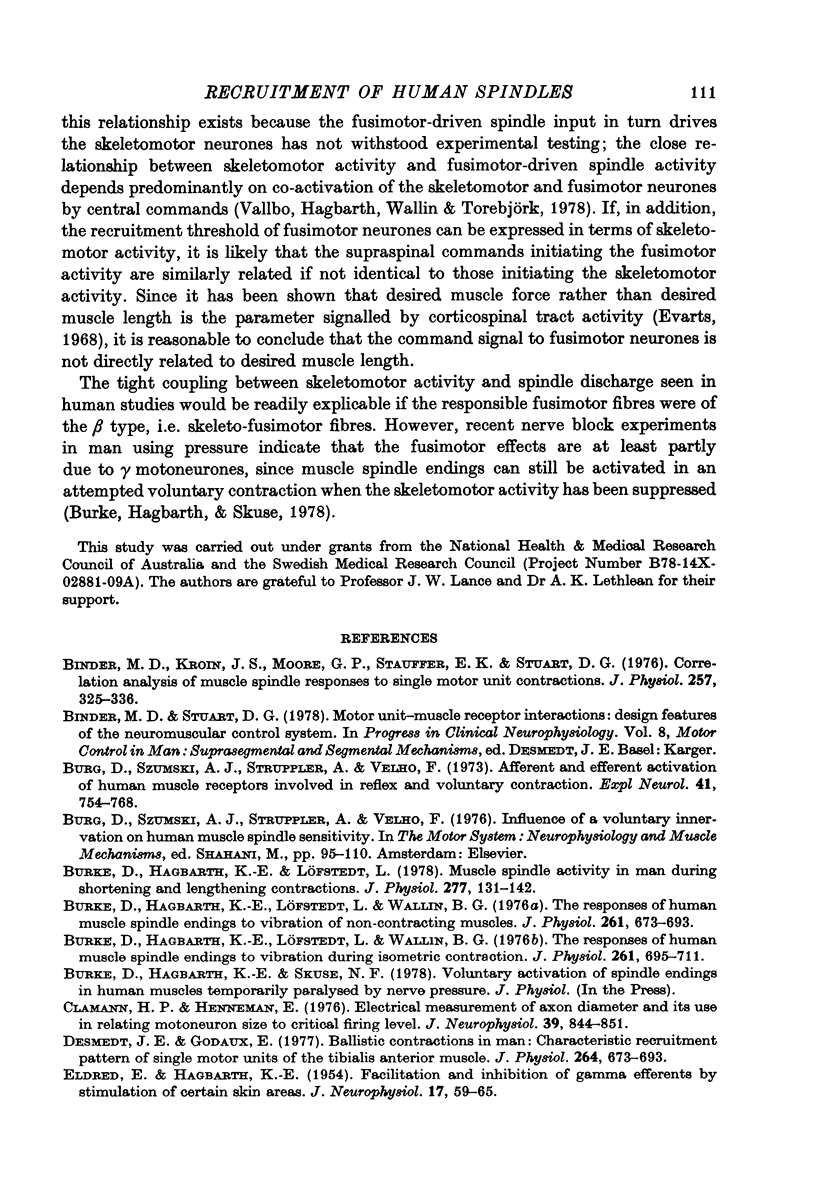
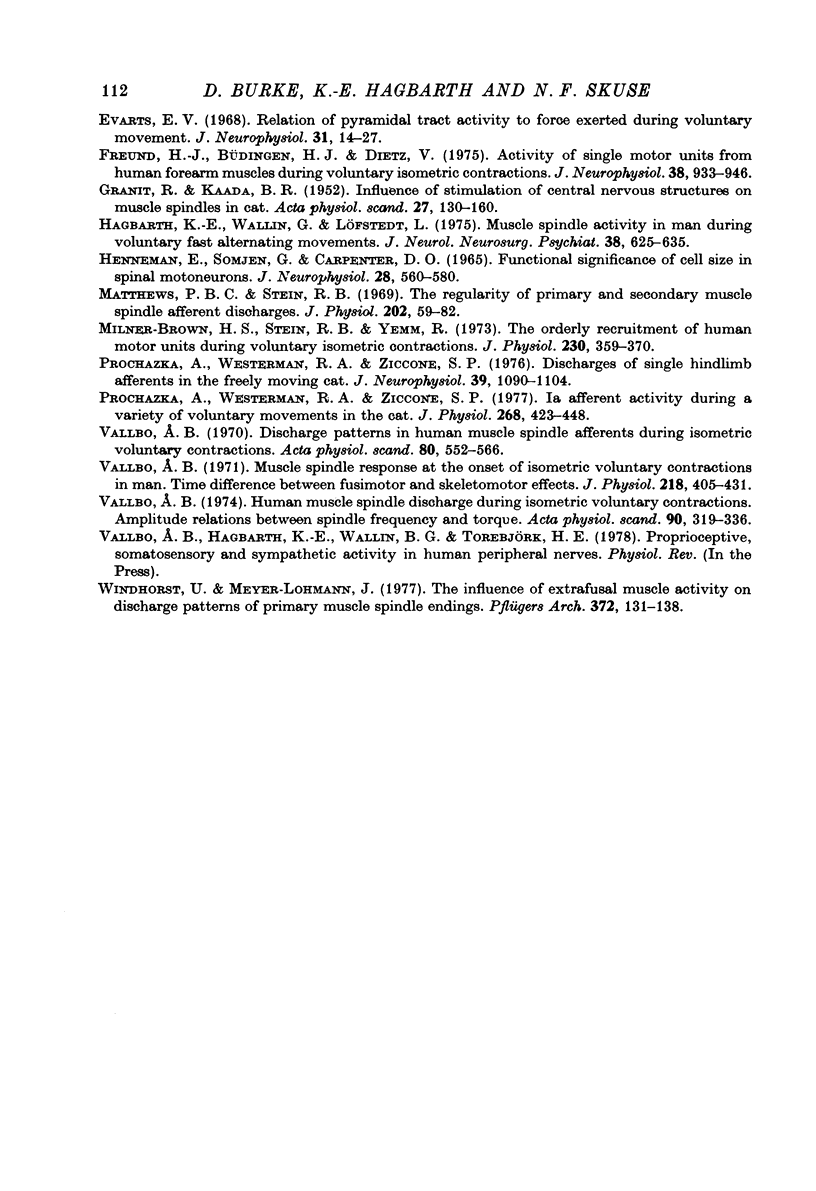
Selected References
These references are in PubMed. This may not be the complete list of references from this article.
- Binder M. D., Kroin J. S., Moore G. P., Stauffer E. K., Stuart D. G. Correlation analysis of muscle spindle responses to single motor unit contractions. J Physiol. 1976 May;257(2):325–336. doi: 10.1113/jphysiol.1976.sp011371. [DOI] [PMC free article] [PubMed] [Google Scholar]
- Burg D., Szumski A. J., Struppler A., Velho F. Afferent and efferent activation of human muscle receptors involved in reflex and voluntary contraction. Exp Neurol. 1973 Dec;41(3):754–768. doi: 10.1016/0014-4886(73)90066-6. [DOI] [PubMed] [Google Scholar]
- Burke D., Hagbarth K. E., Löfstedt L. Muscle spindle activity in man during shortening and lengthening contractions. J Physiol. 1978 Apr;277:131–142. doi: 10.1113/jphysiol.1978.sp012265. [DOI] [PMC free article] [PubMed] [Google Scholar]
- Burke D., Hagbarth K. E., Löfstedt L., Wallin B. G. The responses of human muscle spindle endings to vibration during isometric contraction. J Physiol. 1976 Oct;261(3):695–711. doi: 10.1113/jphysiol.1976.sp011581. [DOI] [PMC free article] [PubMed] [Google Scholar]
- Burke D., Hagbarth K. E., Löfstedt L., Wallin B. G. The responses of human muscle spindle endings to vibration of non-contracting muscles. J Physiol. 1976 Oct;261(3):673–693. doi: 10.1113/jphysiol.1976.sp011580. [DOI] [PMC free article] [PubMed] [Google Scholar]
- Desmedt J. E., Godaux E. Ballistic contractions in man: characteristic recruitment pattern of single motor units of the tibialis anterior muscle. J Physiol. 1977 Jan;264(3):673–693. doi: 10.1113/jphysiol.1977.sp011689. [DOI] [PMC free article] [PubMed] [Google Scholar]
- ELDRED E., HAGBARTH K. E. Facilitation and inhibition of gamma efferents by stimulation of certain skin areas. J Neurophysiol. 1954 Jan;17(1):59–65. doi: 10.1152/jn.1954.17.1.59. [DOI] [PubMed] [Google Scholar]
- Evarts E. V. Relation of pyramidal tract activity to force exerted during voluntary movement. J Neurophysiol. 1968 Jan;31(1):14–27. doi: 10.1152/jn.1968.31.1.14. [DOI] [PubMed] [Google Scholar]
- Freund H. J., Büdingen H. J., Dietz V. Activity of single motor units from human forearm muscles during voluntary isometric contractions. J Neurophysiol. 1975 Jul;38(4):933–946. doi: 10.1152/jn.1975.38.4.933. [DOI] [PubMed] [Google Scholar]
- GRANIT R., KAADA B. R. Influence of stimulation of central nervous structures on muscle spindles in cat. Acta Physiol Scand. 1952;27(2-3):130–160. doi: 10.1111/j.1748-1716.1953.tb00930.x. [DOI] [PubMed] [Google Scholar]
- HENNEMAN E., SOMJEN G., CARPENTER D. O. FUNCTIONAL SIGNIFICANCE OF CELL SIZE IN SPINAL MOTONEURONS. J Neurophysiol. 1965 May;28:560–580. doi: 10.1152/jn.1965.28.3.560. [DOI] [PubMed] [Google Scholar]
- Hagbarth K. E., Wallen G., Löfstedt L. Muscle spindle activity in man during voluntary fast alternating movements. J Neurol Neurosurg Psychiatry. 1975 Jul;38(7):625–635. doi: 10.1136/jnnp.38.7.625. [DOI] [PMC free article] [PubMed] [Google Scholar]
- Matthews P. B., Stein R. B. The regularity of primary and secondary muscle spindle afferent discharges. J Physiol. 1969 May;202(1):59–82. doi: 10.1113/jphysiol.1969.sp008795. [DOI] [PMC free article] [PubMed] [Google Scholar]
- Milner-Brown H. S., Stein R. B., Yemm R. The orderly recruitment of human motor units during voluntary isometric contractions. J Physiol. 1973 Apr;230(2):359–370. doi: 10.1113/jphysiol.1973.sp010192. [DOI] [PMC free article] [PubMed] [Google Scholar]
- Prochazka A., Westerman R. A., Ziccone S. P. Discharges of single hindlimb afferents in the freely moving cat. J Neurophysiol. 1976 Sep;39(5):1090–1104. doi: 10.1152/jn.1976.39.5.1090. [DOI] [PubMed] [Google Scholar]
- Prochazka A., Westerman R. A., Ziccone S. P. Ia afferent activity during a variety of voluntary movements in the cat. J Physiol. 1977 Jun;268(2):423–448. doi: 10.1113/jphysiol.1977.sp011864. [DOI] [PMC free article] [PubMed] [Google Scholar]
- Vallbo A. B. Discharge patterns in human muscle spindle afferents during isometric voluntary contractions. Acta Physiol Scand. 1970 Dec;80(4):552–566. doi: 10.1111/j.1748-1716.1970.tb04823.x. [DOI] [PubMed] [Google Scholar]
- Vallbo A. B. Human muscle spindle discharge during isometric voluntary contractions. Amplitude relations between spindle frequency and torque. Acta Physiol Scand. 1974 Feb;90(2):319–336. doi: 10.1111/j.1748-1716.1974.tb05594.x. [DOI] [PubMed] [Google Scholar]
- Vallbo A. B. Muscle spindle response at the onset of isometric voluntary contractions in man. Time difference between fusimotor and skeletomotor effects. J Physiol. 1971 Oct;218(2):405–431. doi: 10.1113/jphysiol.1971.sp009625. [DOI] [PMC free article] [PubMed] [Google Scholar]
- Windhorst U., Meyer-Lohmann J. The influence of extrafusal muscle activity on discharge patterns of primary muscle spindle endings. Pflugers Arch. 1977 Dec 12;372(2):131–138. doi: 10.1007/BF00585326. [DOI] [PubMed] [Google Scholar]


